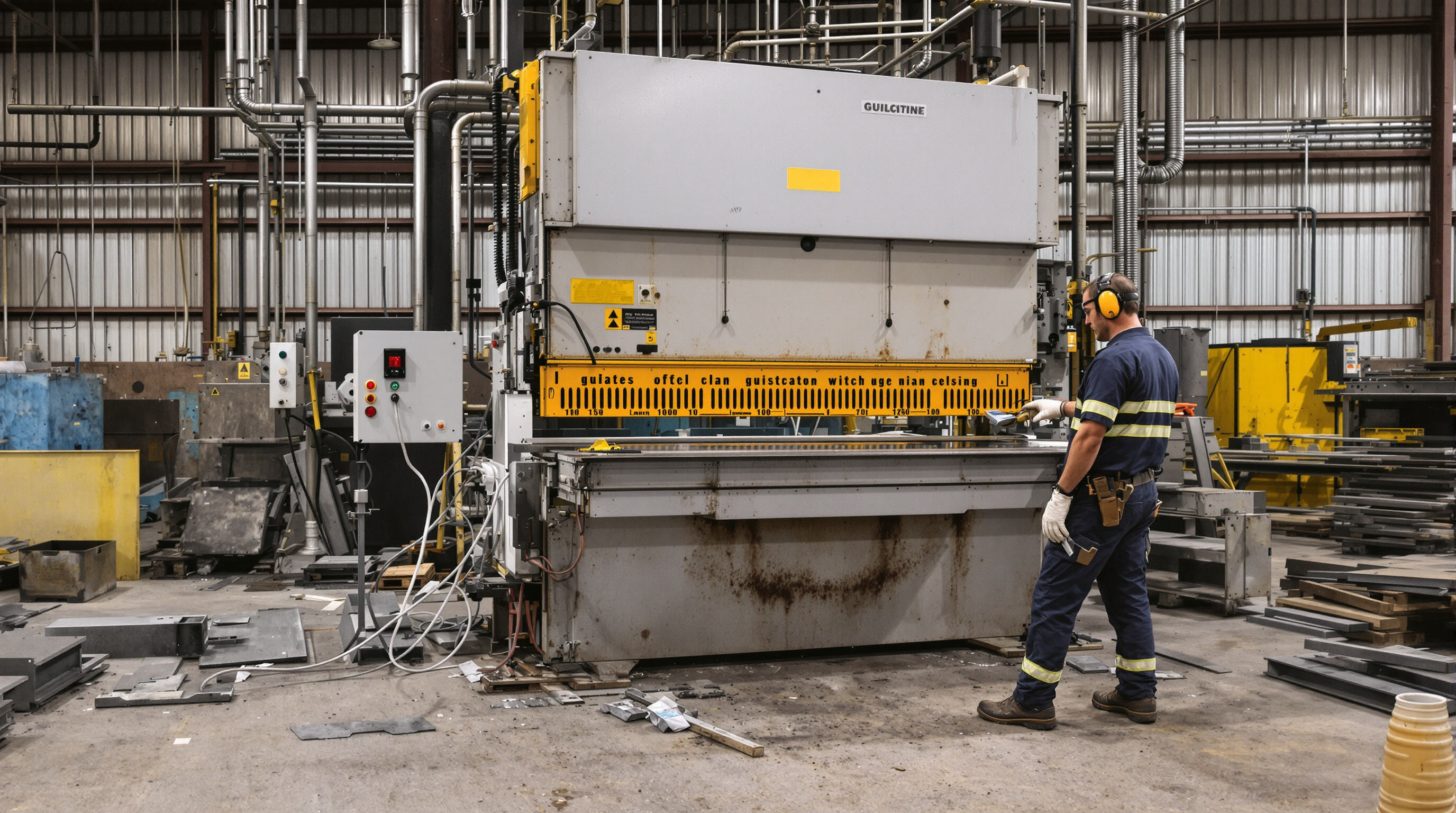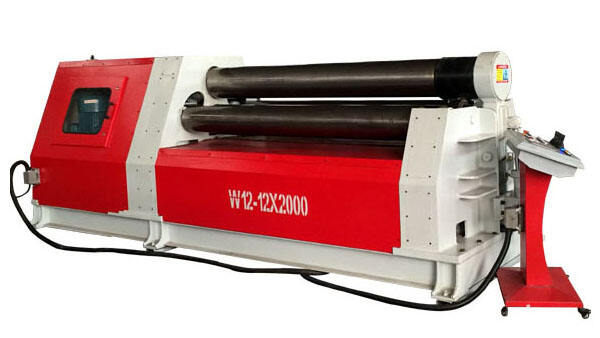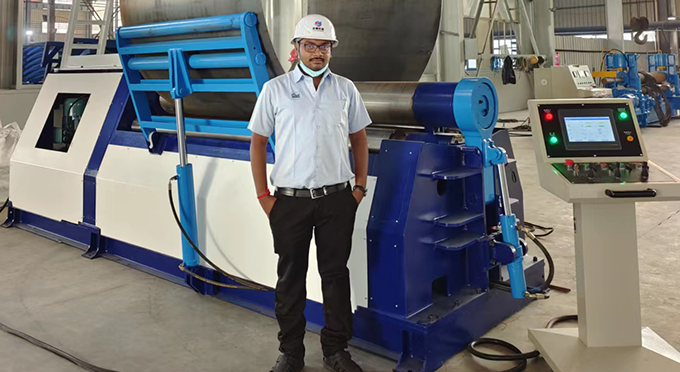Pre-Operation Safety Checks for Guillotine Shearing Machines

Identifying Common Hazards Associated with Guillotine Shearing Machines
Most accidents with guillotine shears happen because of sharp blades, moving parts sticking out, or problems with the hydraulic systems, according to the Metalworking Safety Report from last year these account for around 62% of all incidents. Operators should always check the machine itself plus everything around it before starting work. Look out for things like leftover bits of metal, materials stacked too high, or anything on the floor that might cause someone to slip or trip over. Also take a good look at the electrical parts to see if there's any damage visible. And don't forget to check those hydraulic lines carefully they need to be completely free of leaks since this is one of the main reasons why pressure drops suddenly while the machine is running.
Using Safety Devices Such as Light Curtains and Emergency Stop Buttons
Guillotine shears today come with infrared light curtains that stop the blades whenever something gets too close to the cutting zone, which usually spans between 10 and 20 millimeters. A good practice is to check this safety feature every day by putting a test block in the cutting area when starting up the machine. If everything works right, the whole operation should shut down instantly. Also worth checking are those emergency stop buttons. They need to require less than 5mm of pressure to activate and should be no more than 600mm away from where operators typically stand. This placement makes all the difference when someone needs to hit the brakes fast in case of an accident.
Required Personal Protective Equipment (PPE) Before Machine Startup
Operators must wear the following PPE before startup:
- Impact-resistant goggles with side shields to protect against flying metal fragments
- Cut-proof gloves rated to ISO 13997 Level 4 for handling sharp-edged materials
- Steel-toe boots to guard against falling objects and provide slip resistance
- Cut-resistant aprons to protect the torso and thighs from sharp edges
- Steel-toed boots to protect the feet from heavy, sharp materials
- Cut-proof gloves for handling sharp-edged materials during loading/unloading
- Noise-canceling earmuffs that reduce ambient noise to below 85 dB(A) during extended operation
Verifying Proper Machine Setup and Functionality
Before starting the guillotine shear, it's critical to verify its setup. Ensure the blades are securely fastened and the back-gauge is positioned correctly for your material specifications. Operators should perform a quick test cut on scrap material to confirm the machine functions correctly. Additionally, verify that all safety devices, such as interlock guards and light curtains, are operational. Regular maintenance and inspection are essential in minimizing risks and maximizing efficiency.
Safe Operation Practices for Guillotine Shears
An established maintenance schedule, aligned with safe operating procedures, can minimize accidents and ensure the longevity of guillotine shears. Operators should be provided with regular training to maintain awareness of potential hazards and the importance of safety mechanisms.
The Critical Role of Safety Checks Before Operation
Before starting each shift, conduct an essential review process. Check for machine functionality, clear away any loose material around operating zones, and confirm that safety devices such as emergency stop buttons are working perfectly. Such precautions substantially reduce accidents, as verified by the latest research.
Operator Training and Awareness in High-Risk Situations
Regular training ensures operators are well-prepared to handle the guillotine shear machinery and navigate potentially high-risk situations effectively. Competency-based training can cut down operator errors significantly, while regular recertification ensures that everyone stays up-to-date with safety practices.
Blade Maintenance and Sharpening for Optimal Performance
Regular Maintenance to Ensure Sharp and Efficient Blades
Properly maintained blades enhance cutting precision while reducing operational costs. Perform weekly inspections and sharpen the blades as necessary. Regular servicing minimizes the risk of machine downtime and optimizes performance.
Inspecting and Maintaining Your Guillotine Shear Blades
Monitor the following during weekly blade inspections:
- Wear: Look for micro-chips larger than 0.5mm using a 10x magnification
- Alignment: Ensure blade alignment remains within 0.02mm using laser measurement
- Integrity: Identify surface irregularities and chipping, along with signs of corrosion
Utilize deburring, polishing, and gauging tools to ensure high-quality cuts and prolong blade life.
Troubleshooting Common Cutting Issues
- Tapered Cuts: Ensure appropriate blade angle and verify alignment for consistent pressure
- Chatter Marks: Inspect clamping pressure of at least 200 bar, especially for thicker materials
- Uneven Cuts: Run diagnostics to check for tool wear and hydraulic system issues
Hydraulic System Care and Maintenance
Routine Checks to Prevent System Failures
Conduct consistent inspections of hydraulic components such as hoses, seals, and reservoirs. Look for leaks and replenishing hydraulic fluids with approved materials, while keeping an eye out for fluctuations in discharge pressure.
Advanced Monitoring and Diagnostic Techniques
Integrating IoT-enabled sensors and regular vibration checks with oil analysis helps in significantly reducing unexpected breakdowns. Implementing an offline filter prevents small particles from damaging the system without requiring work stoppage.
Balancing Efficiency with Safety Protocols
While operational efficiency is essential for profitability, bypassing safety systems can lead to severe injuries and costly mistakes. Enhanced monitoring systems that log every time safety features are altered can help maintain optimal safety standards. Ongoing investment in safety technologies protects both personnel and equipment.
Lockout/Tagout and Maintenance Safety Protocols
Critical Steps to Ensure Worker Safety During Repairs
The correct application of LOTO procedures eliminates many potential maintenance-related injuries. Place emphasis on cutting off all power sources while performing maintenance and repairs. Ensure that residual pressure is minimized in accumulator tanks and that proper safety equipment is worn throughout the process. Real-time communication between team members regarding the status of maintenance tasks should be encouraged to avoid misunderstandings.
Balancing Safety and Operational Efficiency
Though bypassing safety mechanisms might seem time-saving, it imposes the dangerous risk of workplace injuries, and many facilities that carefully monitor and limit such practices manage to sustain higher overall safety and operational efficiency.
FAQ Section
What are the common hazards associated with guillotine shears?
Common hazards involve sharp blades, exposed moving parts, and issues with hydraulic systems. These account for about 62% of all guillotine shear-related incidents.
What are essential pre-operation safety checks for guillotine shears?
Operators should check the machine and its surroundings for potential hazards like leftover metal bits, stacked materials, floor obstacles, visible electrical damage, and hydraulic leaks before starting the machine.
How do safety devices enhance operational safety in guillotine shears?
Infrared light curtains and emergency stop buttons can quickly halt machine operation when anything approaches the cutting zone, thereby preventing accidents.
What personal protective equipment (PPE) is needed for using guillotine shears?
PPE includes impact-resistant goggles with side shields, cut-proof gloves rated to ISO 13997 Level 4, steel-toe boots with metatarsal guards, cut-resistant aprons, and noise-canceling earmuffs.
How important is blade maintenance on guillotine shears?
Regular blade maintenance is crucial as it enhances cutting precision, reduces power consumption by up to 25%, and prevents excessive wear on hydraulic components.
What are proactive practices to prevent hydraulic system failures?
Routine maintenance such as performing regular system flushes, using approved fluids, and conducting diagnostics with vibration checks or oil analysis significantly reduces the risk of unexpected breakdowns by approximately 55%.
What is the lockout/tagout protocol in guillotine shearing machine maintenance?
Lockout/Tagout involves cutting power to the machine, releasing pressure in accumulator tanks, and securely locking components to prevent unexpected starts during maintenance.
Table of Contents
-
Pre-Operation Safety Checks for Guillotine Shearing Machines
- Identifying Common Hazards Associated with Guillotine Shearing Machines
- Using Safety Devices Such as Light Curtains and Emergency Stop Buttons
- Required Personal Protective Equipment (PPE) Before Machine Startup
- Verifying Proper Machine Setup and Functionality
- Safe Operation Practices for Guillotine Shears
- The Critical Role of Safety Checks Before Operation
- Operator Training and Awareness in High-Risk Situations
- Blade Maintenance and Sharpening for Optimal Performance
- Hydraulic System Care and Maintenance
- Lockout/Tagout and Maintenance Safety Protocols
- FAQ Section




